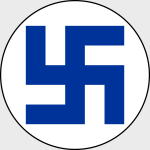Atlas Editions ATL7896030 Finnish Brewster Model 239 Buffalo Fighter - Hans Henrik Wind, 3./Lentolaivue 24, 1943 (1:72 Scale)
"If you threaten Finns, they do not become frightened - they become angry. And they never surrender."
- Ilmari Juutilainen
 Built by the Brewster Aeronautical Corporation in Queens, New York City, the F2A Buffalo was the first production monoplane fighter to enter service with the US Navy. The F2A was an all-metal, single-engine, single-seat, mid-wing monoplane with retractable landing gear and a tail hook for carrier operations. The control surfaces, i.e., ailerons, elevators and rudder, were metal framed but covered with fabric. The struts of the hydraulically-operated landing gear retracted into the underside of the wing while the wheels fitted into the stubby fuselage below the wings. The tail hook was fully retractable into the rear fuselage while the tail-wheel partially retracted into the rear fuselage. Because of its short wingspan, the F2A did not need a folding wing configuration to be accommodated on U.S. aircraft carriers.
Built by the Brewster Aeronautical Corporation in Queens, New York City, the F2A Buffalo was the first production monoplane fighter to enter service with the US Navy. The F2A was an all-metal, single-engine, single-seat, mid-wing monoplane with retractable landing gear and a tail hook for carrier operations. The control surfaces, i.e., ailerons, elevators and rudder, were metal framed but covered with fabric. The struts of the hydraulically-operated landing gear retracted into the underside of the wing while the wheels fitted into the stubby fuselage below the wings. The tail hook was fully retractable into the rear fuselage while the tail-wheel partially retracted into the rear fuselage. Because of its short wingspan, the F2A did not need a folding wing configuration to be accommodated on U.S. aircraft carriers.
The Buffalo entered squadron service in the summer of 1940 and it was not long before three serious defects were identified. The first was the landing gear; it was not strong enough for carrier operations. Brewster strengthened two weak struts but a real fix would require a redesign of the aircraft. The second defect was identified by reports from Europe which indicated that the Buffalo did not meet the performance criteria of other aircraft then in combat, e.g., armor protection, self sealing fuel tanks, etc. Armor protection was added to the F2A-3 resulting in a heavier, unstable aircraft. One solution was to use a more powerful Pratt & Whitney engine but this would require a redesign of the aircraft. The third problem was the Brewster company management who had a habit of promising more than they could deliver resulting in serious delays in the deliveries of the aircraft. The final straw came when the Navy realized that the Grumman F4F-3 Wildcat was a superior aircraft in virtually every respect so no further Buffalos were ordered.
Pictured here is a 1:48 scale replica of a Finnish Brewster Model 239 Buffalo fighter that was piloted by Hans Henrik Wind, who was attached to 3./Lentolaivue 24 during 1943.
Now in stock!
Dimensions:
Wingspan: 8-3/4-inches
Length: 6-1/2-inches
Release Date: September 2019
Historical Account: "Gone With the Wind" - Hans Henrik "Hasse" Wind (July 30th, 1919, Ekenas - July 24th, 1995, Tampere) was a Finnish fighter pilot and flying ace in World War II, with 75 confirmed air combat victories. He is one of the four double recipients of the Mannerheim Cross 2nd Class.
Wind started his pilot career in 1938 by volunteering to join a pilot training course. He was a reserve officer in the Winter War (1939-1940), but did not fly due to a lack of available planes. Wind had now decided to embark on a military career, and he finished training as a lieutenant on June 17th, 1941.
Transferring to LeLv24 in August 1941, he fought in the Continuation War. He flew a Brewster B239 (the export version of the Brewster Buffalo) from 1941-1943, claiming 39 of his victories in the type. On September 22nd, 1941, Wind was credited his first kill, a I-15. In August 1942, the squadron was transferred to Rompotti to operate over the eastern Gulf of Finland. On 14 August 1942, Wind shot down two Hurricanes, and four days later a Hurricane and two I-16s. At the end of 1942, his score stood at 14.5 claims. On April 5th, 1943, Wind shot down three Il-2s. On April 14th, Wind claimed two Spitfires, and on April 21st two Yak-1s and shared one with fellow ace Sgt Kinnunen. In August 1943, the unit converted to the Messerschmitt Bf 109G.
Wind was awarded his first Mannerheim Cross on July 31st, 1943, and his second on June 28th, 1944.


